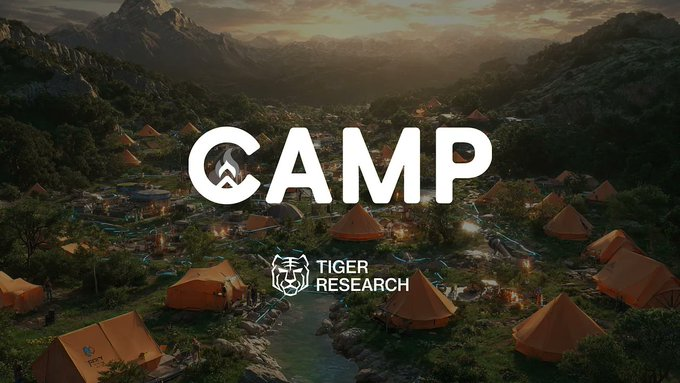Camp Network: A Data Ownership Revolution in the AI Era
In 2025, the AI industry faces a dire challenge: human-generated data is nearing depletion, and unauthorized data scraping has triggered lawsuits from Reddit, Anthropic, and others. Creators lose over $2.7 billion annually in royalties. Against this backdrop, Camp Network emerges as an “autonomous IP layer,” connecting creators with AI agents via blockchain to build a new paradigm in data ownership and value distribution. In April 2025, it closed a $25 million Series A (led by 1kx and Blockchain Capital) with a valuation of $400 million. The testnet has processed over 50 million transactions and attracted more than 4 million wallet addresses.

This Token Insights article dives into Camp Network’s technical architecture and token model, exploring how its provenance protocol solves AI training data infringement and reshapes the creator economy value chain.
Strategic Evolution: From Social Data Sovereignty to AI IP Infrastructure
Camp Network’s path reflects a deep Web3 reconstruction of the data economy:
-
2024 (initial focus): Social data sovereignty. Users carry YouTube, TikTok, and other data across chains using “digital backpacks,” enabling shared revenue.
-
2025 (strategic upgrade): Addresses AI training data infringement crisis with the “provenance protocol,” putting data ownership, usage authorization, and royalty distribution fully on-chain. It resolves three key issues:
-
Data misuse: AI models scrape content without permission, causing legal disputes;
-
Value misalignment: Creators cannot trace derivative work revenue;
-
Supply exhaustion: High-quality training data expected to deplete by 2026.
-
The pivot earned 40% more fundraising than peers like Story Protocol.
Technical Architecture: Three-Layer System Rebuilding IP Value Chain
1. Infrastructure Layer: BaseCAMP + SideCAMPs
-
BaseCAMP is a Layer 1 chain optimized for IP, integrated with Celestia for data availability, processing 50,000 TPS with 100 ms blocks—meeting demands for high-frequency copyright settlements.
-
SideCAMPs are vertical chains—for example, a music royalty SideCAMP offering creators real-time 30% revenue from secondary creations, and a game assets SideCAMP for provenance tracking.
2. IP Management Layer: Origin Framework
The Origin Framework enables creators to mint text, audio, or video as ERC-721 NFTs and generate unique “IP graph” identifiers. This system auto-tracks derivative content paths and triggers royalty payments whenever AI covers a song or adapts a comic. Built-in plagiarism detection achieves 92% accuracy, exceeding the industry average of 67%, reducing infringement disputes.
3. AI Agent Layer: mAItrix Framework
mAItrix offers AI developers a compliance-focused training environment via trusted execution environments (TEE), ensuring models use only authorized data. All AI-generated content embeds provenance hashes, enabling full traceability from original creation to derivatives. Developers can refer to JuCoin’s smart contract guide to implement similar copyright-management logic.
Tokenomics: Dual Flywheel Effects of $CAMP
Token utilities and consumption
$CAMP fuels three major use cases: registering IP costs 1.2 tokens; calling AI data costs 0.5 tokens each; governance requires staking. Validator nodes earn 8–12% annually, incentivizing decentralization.
Deflationary model
The token economy builds a self-reinforcing cycle: creators spend CAMP to register IP; AI firms pay for data usage, burning tokens; protocol burns 30 CAMP per transaction. Testnet burns ~180,000 CAMP daily—projected to quintuple at mainnet launch. With a fixed supply of 1 billion CAMP, allocations include 30% community incentives (airdrop & dev grants), and 20% team tokens unlock over 4 years to sustain long-term ecosystem stability.
Ecosystem Progress: From Remix Culture to Trillion-dollar IP Market
Strategic partnerships and creator adoption
In a July 2025 acquisition, Camp Network integrated the AI remix tool KORUS, linking top artists’ libraries like deadmau5 for real-time royalty sharing. Using LayerZero cross-chain protocol, IP assets freely move across 50+ ecosystems (Ethereum, BNB Chain, etc.). Testnet data shows over 300,000 independent IP registered; a comiс co-built with Rob Feldman reached 200,000 users—demonstrating commercial viability.
Developer ecosystem
The Builder Grants program funded 16 teams building games and comics, with winning teams receiving CAMP tokens and Gas subsidies. Regular users earn star points via daily check-ins to redeem limited-edition NFTs, fostering active community participation.
Challenges & Outlook: Building the Foundation for a New Data Economy
Regulatory & technical risks
The EU AI Act mandates full training‑data transparency, forcing Camp to adapt metadata standards dynamically. Cross-border lawsuits (e.g., against Stability AI) may affect on-chain copyright logic. Technically, Instagram API calls can cost $0.01 each—costs may shift to creators.
Growth catalysts & long-term value
Policy tailwinds are emerging: regions like Shandong (China) and South Korea have included AI data ownership in digital economy plans. Facing an impending 2026 scarcity of human data, AI firms will need compliant, on-chain data sets. With over 10 Builder Grants projects launching in Q3—covering fashion NFTs and film IP derivatives—Camp Network is poised to become the value settlement layer for a trillion‑dollar AI‑training market. The core innovation: when melodies carry provenance hashes and AI agents partner with creators rather than exploit them, the knowledge economy will shift from zero-sum competition to sustainable collaboration.





